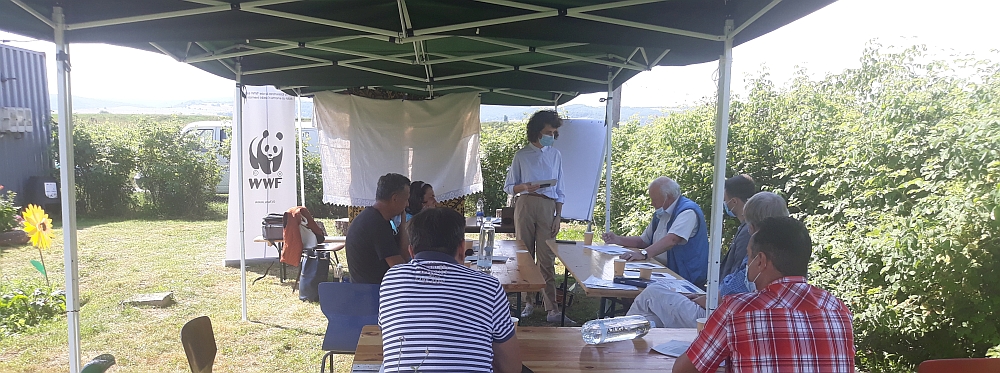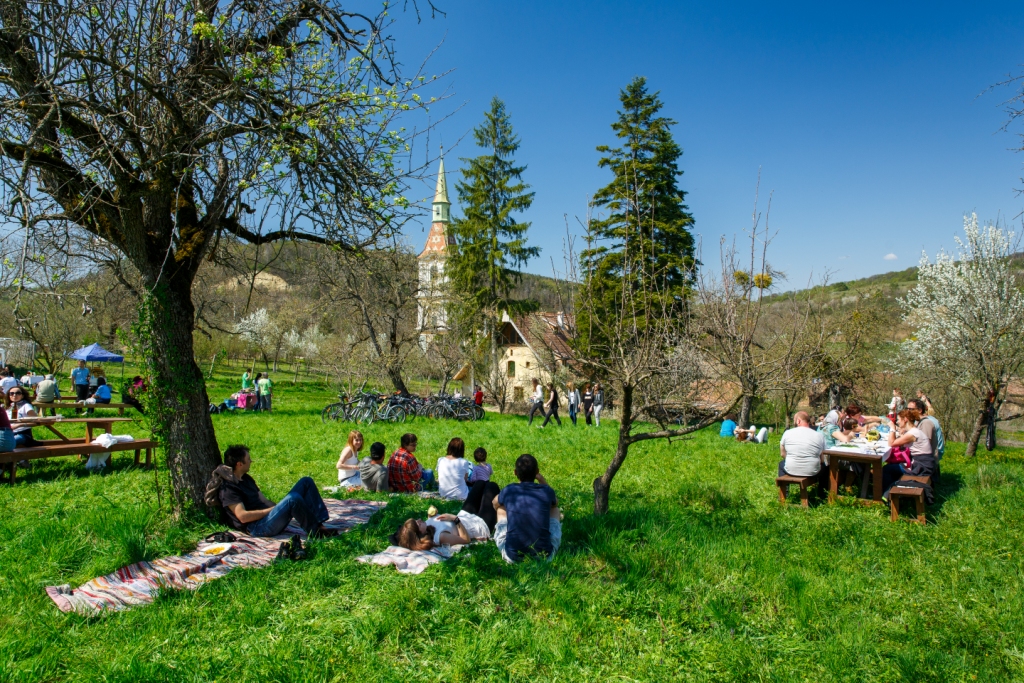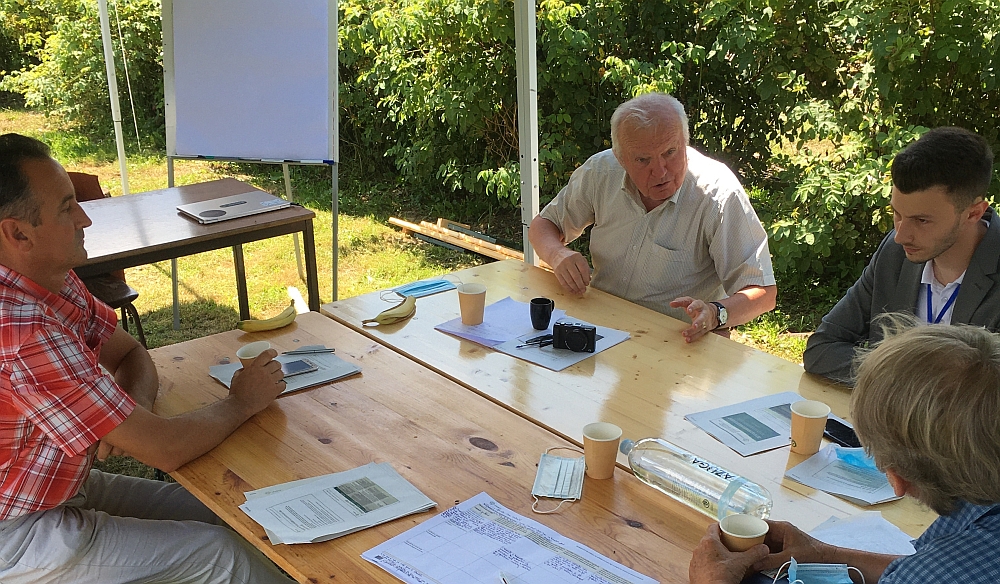Tools to identify and support positive change in your setting
- In your projects: the transdisciplinary approach through Multi-Actor Platforms (MAPs)
- In the governance dimension of your local agricultural context: the Social Network Analysis (SNA)
- In your local/regional/national market and policy framework: the Multi-Criteria Analysis of market and policy instruments (MCA)
In your projects: the transdisciplinary approach through Multi-Actor Platforms (MAPs)
The MAPs are an important element of the transdisciplinary character of the UNISECO project. A key aim of the use of the MAPs is to operate without gaps between science and practice, and to provide an advisory framework that will support a “systems approach” to the topic you want to tackle.
This approach acknowledges the value and necessity of bringing together multiple sources of knowledge and experience, from across different backgrounds, roles and disciplines (i.e. science, practice, business, enterprises, advisory services, NGOs, training and education); categories of actors (knowledge producers, users and intermediaries between the two, networks, clusters); and capable of reflecting (on) different types of innovation (technological, social, organisational).
The Multi-Actor Platforms (MAPs) of UNISECO provided ongoing involvement, and an open two-way exchange of ideas for co-learning and co-creation of knowledge with end users and stakeholders in farming at the levels of the EU and the local case studies. Each MAP was comprised of 10 to 20 representatives, selected to reflect the range of relevance to the topic of the project – the transition to, and support of agro-ecological farming systems in the EU - and its case studies. Membership of MAPs included individuals, groups and/or institutions which affect, or are affected by the processes and outputs of agro-ecological farming systems including NGOs and advisory/service providers, policy implementation officers and public administration, food value chain representatives, farmers. The MAP participants provided advice and feedback on activities and materials, ensuring relevance of outputs to their needs, and were involved in the identification of key barriers and drivers for the transition to AEFS, evaluation and co-construction of management strategies and policy and market incentives to strengthen AEFS, to name a few.
Guidelines to apply the MAP approach in your setting
Please find enclosed two methodological briefs that we put together in order to help any organisation interested in testing/using this approach to address complex topics such as those related to agro-ecological farming systems. You can read more in detail in D7.3 - Report on the Assessment of Transdisciplinary Tools and Methods on how to evaluate the quality of interaction and the results of a MAP, as well as details from such an evaluation of the MAPs that were assembled in UNISECO.
Download:
D7.3 - Report on the Assessment of Transdisciplinary Tools and Methods (pdf)
In the governance dimension of your local agricultural context: the Social Network Analysis (SNA)
The SNA is defined as mapping and measuring of relationships and flows between people, groups, organisations, computers or other information/knowledge processing entities (Krebs, 2010). The social relational approach to natural resources management, as implemented through the SNA, allows investigating how patterned relationships among actors within a system enable and constrain human action on natural resources (Bodin and Prell, 2011). And it is also a means of visualising the power of the connections between people, which enables the identification of how interaction and knowledge sharing is structured and how it can be optimised.
The SNA can be carried out through either quantitative and/or qualitative approaches. In UNISECO, the analysis was done through a mixed method approach, with the following objectives:
- To identify and analyse the most relevant actors for addressing key agro-ecological ”dilemmas” (challenges) in the 15 case studies (across the seven main types of actors: farmers; authorities and administrations; agri-food value chain actors; science, innovation, advisory and capacity building actors; NGOs, civic society organisations, local community representatives; consumers; media), uncovering their roles, positions, points of view;
- To identify and analyse the governance networks with relevance for each challenge, uncovering the rules, regulations, power relations, conflicts, collaborations, collective action dynamics, the flows of knowledge and tangible goods, to understand the decision-making processes and how the network and its elements (actors and actor-actor links) can influence pathways of transitions to agro-ecology.
The analysis thus went well-beyond the farm level, by looking at how different stakeholder groups are engaged in the transition processes towards sustainable agriculture and food systems. And the NET-MAP (network mapping) was the toolbox used for the joint development of network maps with local stakeholders and for interactive analysis, with the objective of ensuring co-production of knowledge, joint learning and favouring transdisciplinary approaches (Hauck et al., 2015; Hauck et al., 2016).
The NET-MAP tool is not a software, but a low-tech, low-cost, interview-based mapping tool. With the term “tool” we refer simply to the necessary kit to carry out the SNA, which includes small figures (or post-it cards) that represent different actors. Lines are drawn to link the actors and reveal how they are connected and, perhaps even more importantly, how they are not connected. It can be used by researchers, facilitators, and implementers to visualise knowledge and understand the interplay of complex formal and informal networks, power relations, and the goals of actors.
Examples of results from the UNISECO case studies: insights from livestock, arable and permanent crops systems, and mixed farming
In Switzerland, the key dilemma was how to reduce the high animal densities and at the same time remaining profitable against the backdrop of important path dependencies (barn constructions, depths, up- and downstream market, knowledge system).
The Swiss case study encompassed the agricultural area in the Lucerne Central Lakes, one of the most intensive pig farming regions in Switzerland as well as in Europe, which causes important environmental problems. It seems that there is a rather general consensus on the need to reduce animal density. The central actors are the farmers. They are connected to the up- and downstream market actors, to the municipality and cantonal actors as well as to actors providing advisory services. To better address the key dilemma, the present network should be improved in different regards: there should be a clearer division between different public offices representing opposing interests. The focus should be less on finding compromises but on the thorough implementation of existing laws. Moreover, the general public, who exerts a high level of influence, should have a more prominent role in the network. There is a lack of communication about the state of the ecosystems and there could be more influence exerted from environmental NGOs. Moreover, production and consumption are almost completely detached from each other with different actors of the downstream-market controlling the market. There should be a closer connection between farmers and consumers to ensure that consumers get a better idea of how their food products are produced.

In Hungary, the key dilemma was how to integrate agro-ecological practices on arable land in highly market-oriented arable farming systems to maintain and improve soil quality without significant negative impacts on the economic viability of farms. Agro-ecological conditions for crop production in Hungary are generally considered to be good, but water shortage during the growing season, climate adaptation and, in particular, deterioration of soils poses increasing environmental challenges to farmers.
Innovative farmers are a specific group somewhat mutually isolated from conventional farmers. Cooperation between NGOs and/or civic society organisations related to the topic of soil conservation is not characteristic neither at a national nor local scale. More cooperation would be needed within and between authorities and science to serve the practical needs of the sector in terms of climate mitigation and preparation for the transition to agroecology in the long run. Lack of skilled agricultural employees with specific knowledge (e.g. precision agriculture) is a big problem. Innovations and digitalisation of the agricultural sector precedes the structure and content quality of agricultural education both at secondary and higher levels due to old structures in courses and topics, as well as, lack of capital for demonstration and training. Farmers need to be encouraged by the government to participate in research projects.
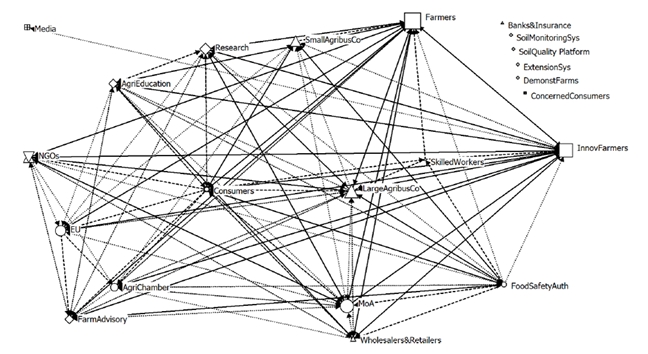
In Italy, the key dilemma was how to promote cropping system diversification in a highly specialised and market-oriented winegrowing area via the adoption of agro-ecological practices, to increase biodiversity and improve landscape management while maintaining the profitability of farming through local value chains.
The case study was in the Chianti Biodistrict. A biodistrict is a geographical area where farmers, citizens, tourist operators, associations and public authorities formalise an agreement for the sustainable management of local resources, based on production and consumption of organic food. In Chianti area, in Tuscany, the creation of the biodistrict allowed the adoption and diffusion of key agro-ecological practices in winegrowing, such as e.g., inter-row grassing, selection of local varieties, maintenance of semi-natural features, as well as the use of organic fertilisers and pesticides and green manure, among others. Despite that, the case study faces the critical challenge of increasing the diversification of the cropping system, to increase biodiversity and improve landscape quality. A possible way towards addressing this challenge is supporting the revitalisation of under-utilised agricultural areas, notably via the restoration of abandoned olive groves, the recovery of arable cropping and pasture land, and the development of the related local value chains. The latter could also increase the resilience of the local farming system, by reducing the dependence on the export of a single product, i.e. wine.
The network of actors involved in the key dilemma in this case study is under development, since the BD is still in the process of developing and extending the information and knowledge connections for the main actions relevant for the key dilemma.
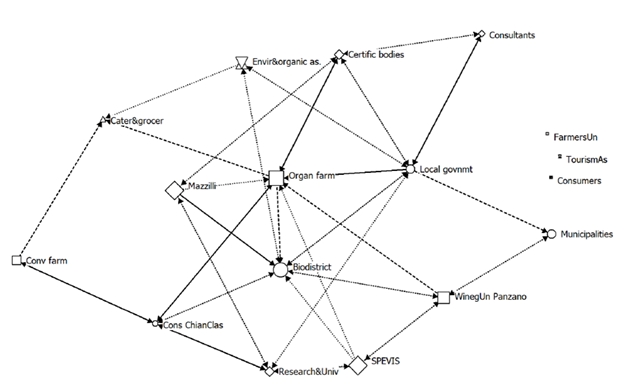
In Romania, the key dilemma was how to increase the economic viability of small-scale farming while preserving the cultural landscape and biodiversity. The high biodiversity in Transylvania and Maramures is tightly linked to the structural diversity and the specific farming and land management practices used by farmers for generations. However, social dynamics and triggers for agricultural intensification causes the landscape to change, which poses a range of risks for sustainability in general, and particularly for biodiversity conservation.
Trust and collaboration are very weak to the social trauma left by the nationalised, collective
agricultural system. Associations exist, but they were founded to comply with eligibility criteria in accessing
agricultural subsidies; cooperatives - an “upgrade” to associations - are missing. Due to the unwillingness to
develop economic activities together and other challenges related to skills, cash flow, access to information and
infrastructures, farmers are stuck in a regime of low productivity, with no means to add value to their raw agricultural
output and create/access the market; thus they represent the weakest player in the supply chain.
The governance model is old-school and hierarchical, and predominantly unilateral/unidirectional: from public
institutions to citizens. Decisions are being taken by people in positions of power and information circulates rather
through informal social channels. LAGs and NGOs play an essential role in informing the local communities of matters of
common interest related to their field of expertise/interest, and representing the voice of communities in
decision-making forums. These organisations also invest in local communities - in ecotourism and food-related
infrastructures/facilities and events, ongoing professional training, or in market development. Another important
working relationship is between farmers/associations of farmers and agricultural payment agencies (APIA, AFIR), whereby
beneficiaries of funds rely on agency employees to not only register their applications, but also help them prepare the
paperwork.
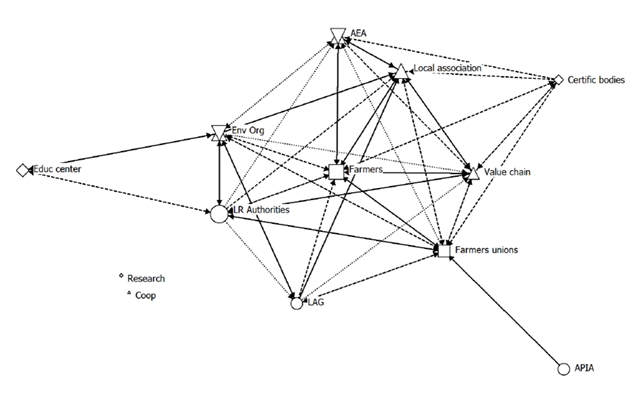
For more details on the examples above and the other 10 case studies read the D5.2 report.
Download:
D5.2 - Governance Networks Supporting AEFS
Guidelines to apply the SNA in your setting
Please find enclosed a brief guideline that we put together in order to help any organisation interested in testing/using this method to better understand their local governance context as a foundation for devising/co-creating better strategies to drive positive change, whether it is in the agricultural sector or another one.
Download:
UNISECO Methodological Brief: Social Network Analysis: Brief Step-by- Step Guide (pdf)
In your local/regional/national market and policy framework: the Multi-Criteria Analysis of market and policy instruments (MCA)
Market and policy instruments (MPIs) - subsidies, incentives, fiscal facilities, programmes etc - are embedded in complex institutional settings, involving many parties with different perspectives and interests, and their ex-ante assessment in a context of a need for policy re-design should consider multiple quantitative and/or qualitative criteria. Decisions in agricultural/environmental contexts need the involvement of a variety of stakeholders with different and conflicting viewpoints, which will enhance the complexity of the decision.
These arguments support the choice to use a Multi-Criteria Analysis (MCA) of MPIs, which is widely applied by national governments and international institutions and many officially released guidelines and ready-to-use tools exist. Here, in UNISECO, the MCA builds on two key official documents, i.e. the Better Regulation Toolbox (EC, 2017) and Multi-Criteria Analysis: A Manual. UK Department for Communities and Local Development (UK-DCLG, 2009).
The key stages in carrying out a MCA are:
- setting your objectives and selecting the MPIs which will undergo the MCA (in the case of UNISECO, we analysed the potential of certain MPIs in aiding the transition to agro-ecological farming systems in the 15 case studies in Europe);
- establishing relevant criteria against which the MPIs will be analysed;
- interviewing relevant stakeholders to rate their preferences for each MPI with respect to the criteria;
- aggregating the scores of each MPI and drawing conclusions.
In this section we are providing the MCA tool created for the objectives of the project and if you are dealing with a similar dilemma or objective regarding a desired transition in farming and food systems, it is here explained in a brief guideline to support you in your analysis and possibly in your decision-making.
Transition strategies to agro-ecological farming systems in the 15 UNISECO case studies included existing MPIs in their current forms, revised MPIs with proposed changes to their current design, and newly proposed MPIs - all of them were grouped into 8 macro-categories: income and market support, agri-environment payments, payments for investments, knowledge promotion, certification schemes, food policies, networking/cooperation, and other measures (e.g. tax policies, landscape/land use management/planning rules, wildlife laws, etc). In total, 148 instruments were analysed, and agri-environment payments were the largest typology.
To pursue the specific objective of the MCA assessment, two type of assessment criteria were defined and used:
- Performance: criteria that assess the extent to which the MPIs support farmers and other actors to overcome the barriers of the agro-ecological transition, which largely depends on how the MPI is designed;
- Relevance: criteria that influence the relevance of the MPI in supporting the transition strategy, by evaluating the relative importance of the instrument and the urgency/timeliness of its implementation.
The MCA was performed through a mixed methods approach - quantitative and qualitative, through interviews and workshops, with the participation of relevant stakeholders in each case study - policy officials, managing authorities, researchers, farmers' unions/associations, environmental and community NGOs, and other stakeholders from the farming sector, services and agri-food chain sufficiently experienced in MPIs. The research approach has improved the understanding of context-specific issues related to the dilemma/challenge in individual case study, by focusing on the assessment of existing and new MPIs, with respect to their potential to foster the transition, and on their practical implications for governance arrangements and policy making.
Sample of results from the UNISECO case studies
We grouped the 15 case studies in two major categories, based on the type of challenge(s) they are facing and the stage of the agro-ecological transition they are in: initiating case studies, which focused on how to initiate/promote the transition in a conventional system by implementing incremental changes - Austria, Switzerland, Germany, Finland, France, Greece, Hungary, Sweden, UK, and enhancing case studies which already implement agro-ecological practices and which focused on further supporting the transition, from farm to food system level, or on maintaining/consolidating existing agro-ecological practices - Czech Republic, Spain, Italy, Lithuania, Latvia, Romania.
Each case study had previously identified a series of barriers that should be removed by the MPIs evaluated through the MCA, to allow the diffusion of agro-ecological practices; barriers ranged from biophysical, technological/knowledge, economic, social, cultural/behavioural, to institutional and policy-related.
In terms of frequency of certain types of MPIs, in initiating cases, MPIs related to barriers in value added, processing and markets were the most frequent, while in enhancing cases, knowledge barriers activated the largest number of MPIs. The focus on value added, processing and markets barriers confirms the need to consolidate the economic and market performance of agro-ecological practices through specific policy interventions. The focus on knowledge problems confirms the crucial role assumed in the agro-ecological transition by the awareness and understanding of the problems to be solved and the willingness to adopt new farm practices.
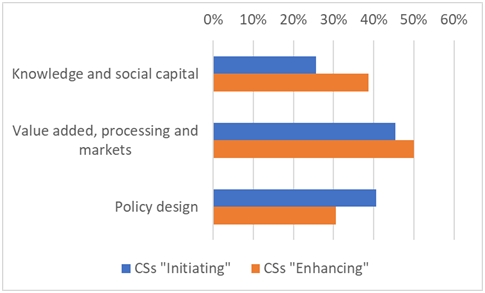
MPIs connected with key barriers (number of MPIs addressed to overcome a specific barrier/total number of MPIs in percentage). Copyright CREA
Initiating and enhancing case studies showed a difference in the MPIs selected for assessment. Initiating cases selected MPIs more oriented towards incentives (agri-environment payments and payments for investments) or the less represented “other measures”. Enhancing cases preferred MPIs related to networking/cooperation and food policies. This is also coherent with the widespread knowledge challenge, e.g. capacity building.
The figure below shows the ranking of MPIs according to their performance and relevance scores attributed by stakeholders engaged in the MCA in all the case studies, with knowledge promotion, networking/cooperation and payments for investments being the top three.
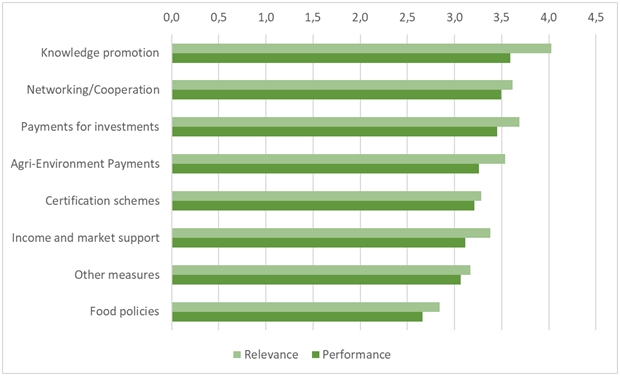
Average performance and relevance scores of MPIs (total case studies). Copyright CREA
The outranking of agri-environment payments by payments for investments highlights the need for structural adaptations in farms that go beyond mere financial compensation for the change of specific farming practices. In other words, to consolidate the transition process, farms require enabling conditions to adopt agro-ecological practices, to overcome the constraints related to insufficient farm endowment.
In initiating case studies, certification schemes rank high both in terms of relevance and performance. The availability of specific certification schemes can provide the right incentive to food chain actors, by increasing the value added to agro-ecological food. Instead, enhancing case studies seem more oriented towards systemic interventions, involving changes beyond farm scale.
Income and market support MPIs were considered not essential or moderately important to initiate
or enhance the adoption of agro-ecological practices, respectively.
Based on these research findings, which are more extensively described in D5.4. Innovative market and policy instruments
to promote the agro-ecological transition strategies, we were able to conclude that they consolidate the importance of
Pillar II instruments (rural development) of the Common Agricultural Policy, especially knowledge promotion, cooperation
and agri-environment payments, for encouraging the agro-ecological transition. This is especially relevant for farms
that are initiating the adoption of agro-ecological practices and that need to cope with the challenge of knowledge
creation.
Download:
D5.4 - Annex 1: Case study summaries (pdf)
Improving farmer knowledge on the benefits of agro-ecological practices and economic opportunities is a key aspect of successful agro-ecological transition strategies. Food policies and certification schemes play a pivotal role by supporting the diffusion of such practices - especially when the transition is initiating - and the related knowledge. Then, promoting horizontal and vertical collaboration in the food chain is of crucial importance to address major transition barriers. Networking/cooperation instruments are crucial to create synergies within and amongst food chains and to build consumer responsibility and involvement, to address the capacity building challenge and enhance agro-ecological practices towards system redesign.
Guidelines to apply the MCA in your setting
Please find enclosed a brief guideline which we put together in order to help any organisation interested in testing/using this method to assess market and policy instruments together with decision-makers, implementers, beneficiaries and other potentially impacted stakeholders, as a foundation for devising/co-creating better strategies and incentives to drive positive change, whether it is in the agricultural sector or another one. Make sure to use the guideline together with the associated assessment matrix (Excel file).
Download:
UNISECO-MCA-tool-assessment-matrix-MPIs_2020_CC.xls
Explore more in SESSIT, the Socio-ecological Systems Interaction Tool
SESSIT provides opportunities for NGOs, civic organisations and local communities working in the field of agri-environment to collect examples of farming systems transitioning from conventional to agro-ecological. They can approach these examples from two directions: reading stories from the farmers' perspective from different countries, working in different farming systems (Agro-ecological farming tab), and/or exploring the policy and market side, with the barriers and drivers which hinder or promote the transition to agro-ecology (Policies and strategies tab). The information and lessons learned can be further used in your own work with farmers and policy makers.

